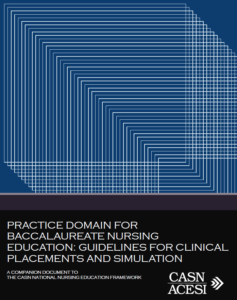 In recent years nursing educators have been struggling with how best to provide practice experiences that prepare students in baccalaureate nursing programs to enter the profession. Considerable diversity has emerged as to how much and what type of clinical placements nursing students receive in Canadian schools of nursing. Historically, except for skills labs, and some community/public health experiences, most practice learning occurred in the acute care sector. The challenge of securing clinical placements for students has driven a search for alternative strategies for practice experiences. Placements have become wide-ranging (Smith, Corso & Cobb, 2010) and simulation is being increasingly used to prepare students for practice. Some educators see simulation as valuable but complementary to clinical placements, others have introduced it as a substitute. An area of research interest has recently emerged investigating the extent to which simulation may be used to replace clinical placements. A national simulation study in the United States, for example, concluded that 50% of clinical placements could be replaced by simulation (Hayden et al., 2014). The purpose of this document is not to examine if or how clinical placements can be replaced with simulation but rather how different types of practice learning in baccalaureate nursing education can together help achieve learning outcomes expected of graduates. It provides guidelines for promoting quality practice-based learning through clinical placements and/or through simulation.
In recent years nursing educators have been struggling with how best to provide practice experiences that prepare students in baccalaureate nursing programs to enter the profession. Considerable diversity has emerged as to how much and what type of clinical placements nursing students receive in Canadian schools of nursing. Historically, except for skills labs, and some community/public health experiences, most practice learning occurred in the acute care sector. The challenge of securing clinical placements for students has driven a search for alternative strategies for practice experiences. Placements have become wide-ranging (Smith, Corso & Cobb, 2010) and simulation is being increasingly used to prepare students for practice. Some educators see simulation as valuable but complementary to clinical placements, others have introduced it as a substitute. An area of research interest has recently emerged investigating the extent to which simulation may be used to replace clinical placements. A national simulation study in the United States, for example, concluded that 50% of clinical placements could be replaced by simulation (Hayden et al., 2014). The purpose of this document is not to examine if or how clinical placements can be replaced with simulation but rather how different types of practice learning in baccalaureate nursing education can together help achieve learning outcomes expected of graduates. It provides guidelines for promoting quality practice-based learning through clinical placements and/or through simulation.
In 2013, a CASN task force with was struck in response to calls from nursing organizations and educators to examine issues related to securing placements for students and the role of simulation in nursing education. Members were drawn from jurisdictions across the country and included nursing experts in clinical education and/or simulation, representatives of stakeholder groups, and both anglophones and francophones. Its mandate was to develop national, consensus-based guidelines for practice learning in baccalaureate education.
The task force identified the following objectives in order to fulfill its mandate:
- Identify the outcome expectations to be achieved through practice learning;
- Examine practice learning through clinical placements and through simulation in relation to outcome expectations;
- Formulate principles for practice learning and specify guidelines for clinical placements and simulation.
Download Document – Practice Domain for Baccalaureate Nursing Education: Guidelines for Clinical Placements and Simulation


